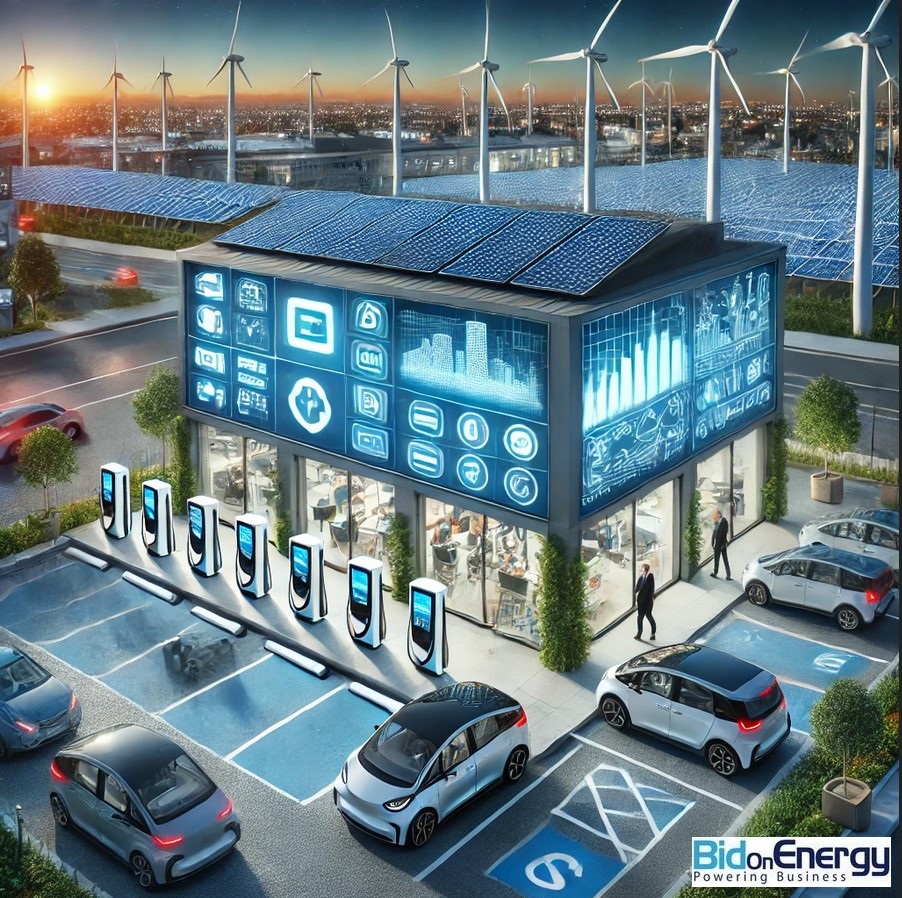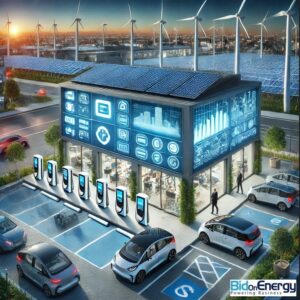Top Trends Shaping Commercial Electricity

Top Trends Shaping Commercial Electricity
The commercial electricity landscape is experiencing significant changes, largely driven by new technology, sustainability initiatives, and the increasing demand for efficient energy solutions. As businesses adapt to these shifts, several key trends are influencing the industry and transforming how energy is consumed and managed. Below are the top five trends shaping commercial electricity supply and usage.
Electrification and Growing Energy Demand
Electrification is one of the most prominent shifts in commercial energy. As industries transition towards electric vehicles (EVs), electrified manufacturing processes, and data centers with energy-intensive operations, electricity demand is rising. For example, the adoption of EVs is driving the need for extensive EV charging infrastructure in commercial buildings.
In response, utility providers and energy planners are focusing on increasing grid capacity and managing higher loads effectively. Many businesses are also taking proactive measures to support electrification by installing EV charging stations and upgrading electrical systems to handle increased demand.
Renewable Energy Integration
Sustainability is a top priority for modern businesses, and renewable energy is playing a critical role in meeting these goals. Solar and wind energy solutions are becoming increasingly popular, especially as commercial properties seek to reduce their carbon footprint and decrease long-term energy costs.
Renewable energy is transforming commercial electricity supply by allowing companies to generate their own power, often using solar panels and wind turbines. This helps businesses reduce reliance on traditional energy sources and mitigate the impact of rising electricity prices.
Energy Storage Solutions
Energy storage has become a vital component of commercial electricity systems, especially for businesses integrating renewable energy sources. Battery storage systems allow companies to store excess energy generated during peak production periods and use it during times of high demand or when renewable generation is low.
This shift toward energy storage helps commercial properties reduce energy costs by avoiding peak pricing and ensures a more reliable supply during outages or periods of grid instability. Energy storage is proving to be an essential tool for businesses seeking to optimize their energy use and maximize the benefits of renewable energy.
Smart Building Technologies
The rise of smart building technologies is revolutionizing commercial electricity consumption. Businesses are increasingly implementing intelligent lighting systems, automated HVAC controls, and advanced energy management software. These technologies enable companies to monitor and optimize energy usage in real-time, resulting in improved efficiency and lower operational costs.
Smart technologies also provide businesses with greater control over their energy consumption, allowing for data-driven decision-making. With real-time monitoring, companies can identify inefficiencies, manage energy consumption more effectively, and reduce overall electricity usage.
Electric Vehicle (EV) Infrastructure
With the increasing popularity of electric vehicles, businesses are investing in EV infrastructure. Installing EV charging stations has become a priority for commercial properties, especially those aiming to attract eco-conscious customers and employees. As more businesses adopt EVs for their fleets, the demand for commercial EV infrastructure continues to grow.
This trend not only helps support sustainability goals but also positions businesses as leaders in the shift toward clean transportation. Commercial properties that provide EV charging solutions are better prepared to meet future demands and contribute to a greener economy.
These trends are reshaping the future of commercial electricity supply, pushing businesses toward more sustainable, efficient, and tech-driven energy solutions. By staying ahead of these developments, companies can optimize their energy usage, reduce costs, and position themselves for long-term success in an increasingly energy-conscious world.
Trends Shaping Commercial Electricity in today’s energy landscape:
1. Electrification of Transport
With the rise of electric vehicles (EVs), businesses are focusing on installing EV charging stations to meet growing demand for commercial EV infrastructure.
2. Energy Storage Solutions
Battery storage is becoming integral for businesses using renewable energy sources, enabling them to store excess power and use it during peak times.
3. Smart Grid Technology
Advanced smart grids allow businesses to better manage electricity loads, optimize energy usage, and avoid grid failures.
4. Renewable Energy Integration
More businesses are shifting to renewable energy sources like solar and wind to meet sustainability goals and reduce electricity costs.
5. Demand Response Programs
Businesses are participating in demand response programs, which offer incentives to reduce electricity consumption during peak times.
6. Energy Efficiency Initiatives
Upgrading equipment and retrofitting buildings to become more energy-efficient is a top priority for reducing overall electricity consumption.
7. Artificial Intelligence and Machine Learning
AI is used to optimize energy management, forecast demand, and improve operational efficiency in real-time for commercial users.
8. Decentralized Energy Generation
Commercial properties are generating their own electricity through rooftop solar panels or microgrids, reducing reliance on centralized power plants.
9. Electricity as a Service (EaaS)
This model allows businesses to pay for energy services without upfront costs by outsourcing energy management to third-party providers.
10. Flexible Contract Options
Businesses are seeking more flexible electricity supply contracts, such as shorter-term agreements and contracts with variable rate options.
11. Time-of-Use Pricing
More businesses are adopting time-of-use pricing models, where electricity rates vary based on demand, to optimize consumption and lower costs.
12. Sustainability Reporting and Carbon Tracking
Energy consumption tracking is becoming essential for sustainability reporting, allowing businesses to monitor and reduce their carbon footprint.
13. Smart Building Integration
Smart systems are enabling businesses to automate lighting, HVAC, and other energy-consuming systems to improve efficiency.
14. Distributed Energy Resources (DERs)
Businesses are investing in DERs like solar panels and small wind turbines to produce power on-site and reduce dependency on the grid.
15. Energy as a Competitive Advantage
Companies are leveraging low energy costs as a competitive advantage, especially in industries where energy costs make up a significant portion of operating expenses.
16. Electrification of Industrial Processes
In energy-intensive industries, companies are electrifying production processes to reduce emissions and improve energy efficiency.
17. Microgrid Expansion
Commercial buildings are increasingly adopting microgrids to maintain power during outages and enhance energy resilience.
18. Electric Heat Pumps
Heat pumps are replacing traditional heating systems in commercial properties to reduce energy consumption and meet emission reduction goals.
19. Cybersecurity in Energy Management
As businesses adopt more smart energy technologies, ensuring the security of digital systems against cyber threats is becoming a top priority.
20. Government Incentives and Regulation
Various government incentives, like tax credits and grants, are encouraging businesses to adopt renewable energy and energy-saving technologies.
These trends illustrate the ongoing transformation in how businesses consume and manage electricity, with a strong focus on sustainability, efficiency, and innovation.

